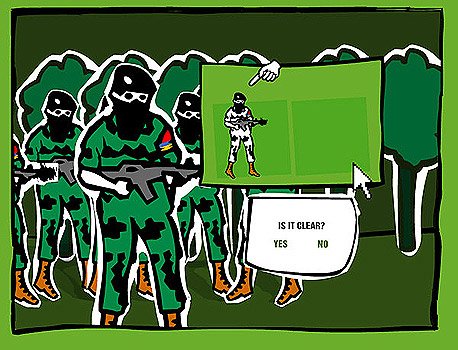Banco de la Republica de Colombia,
Sep 05, 2007 - Mar 05, 2008
Bogota, Colombia
Net Art in Colombia: It's Ugly and Doesn't like the Cursor
by Eduardo Navas
The concept of net art worth exploring solely as a medium striving for autonomy may not be the main subject of preoccupation of Colombian artists -at least, this is the premise one senses from Devis's selections. Viewers are inclined to argue that the participants consider the Internet primarily a tool, which they realize will redefine the way their message is understood as part of online activity, and in this way Devis's curatorial premise is reaffirmed, while also exposing a paradox that takes place in art practice recurrently: as emerging activities or aesthetics attain recognition in cultural institutions such as the arts, they also begin to lose their immediate effect in the community or locality where they started, and find refuge in a rhetorical space, where the privileged few can ponder upon aesthetics with specialized language. This has been a constant preoccupation of artists in the past, as can be argued following criticism of previous practices such as Conceptual Art, for instance, by art critics like Alexander Alberro and Blake Stimson in their book Conceptual Art: A Critical Anthology (1999). Stimson, in particular questions the actual relationship of conceptualism to the real world, as well as the real change that conceptual artists, specifically from the New York scene brought to the arts during its heyday in the seventies, because most of conceptual works were developed in or for the white cube. This preoccupation is relevant to the exhibition curated by Juan Devis mainly because he claims a connection to a conceptual paradigm in his approach to the online projects. However, the situation is quite different in the case of Devis. The participants, for the most part, are not in the white cube at all. And their work has already attained cultural value "prior to the exhibition" by the fact that communities participate in the ongoing development of their projects. In other words, unlike the preoccupation of artists who try to be part of the white cube because they consider doing so the only way to be recognized culturally (which is as Stimson explained was expected of art practices like conceptual art), participants in Devis's net art exhibition, while certainly having no problem with being acknowledged by the artworld, appear to understand that the true validation of their work lies on whether the communities they are targeting actually contribute to the projects; to further complicate the matter, if the artist's ultimate goal is to be part of the artworld, the only way that they can achieve this is if, and only if their projects are successful outside the artworld, to then crossover. This is true of works like Bogowiki as well as open source projects like Slow. But to be fair, while some participants may not be preoccupied to eventually be accepted in some form by the art institution, others do appear to be interested in assimilation; this is more of a personal issue, as the works do not need acknowledgement from the art institution to be effective. Only time will tell how effective these projects are now that they enter the discourse of art internationally thanks to their availability online. Furthermore, the projects demand respect for Colombian culture from those who are viewing the online exhibition from the outside, and exposes how preoccupations about art practice that have been at play in other areas of the world need not apply to Colombia, although it is evident that some interests do crossover.
What is most evident in the exhibition is the interest by artists to bring together art and new media as powerful partners to create a space where critical reflection can reach diverse people across classes. Indeed, I feel that I've learned a lot about Colombian culture by spending time with the selections featured in this exhibition, and I did not need to travel to Colombia to understand the interests and the messages that the participants are interested in communicating. I would certainly learn more if I were able to visit Colombia while contemplating the works, but the sensitivity with which the online exhibition is curated facilitates better understanding of the complexity of culture in Colombia, not only in terms of their own politics and history, but also in terms of global development. The exhibition aims to debunk myths and stereotypes; and Devis successfully contributes to online practice that is invested in appropriation of material in the name of critical reflection, as opposed to mindless consumerism supported by data mining and other forms of online activities where the user is constantly asked to contribute personal information in order to become a more efficient consumer.
Eduardo Navas
Link: artenlared
|











